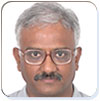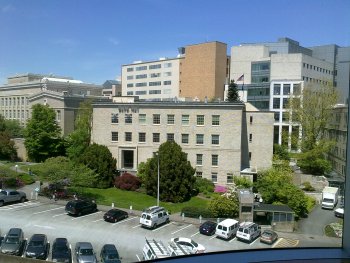The ERSAP Preceptorship Program – Perspective from the Preceptor
 The journey started with a thorough reading of material that the iCMLf provided on its website as well as on a pen-drive. The information was rich in content, authoritative and coherent. The management guidelines were not new, but something I could look forward to seeing being implemented at a world-class center. I carried the Emperor of Maladies (by Siddarth Mukherjee) to read along on the 28-hour journey. While it may not sound novel reading for oncologists, it gives a glimpse of the emotional isolation that patients face as well as the rigor of training a fellow in oncology training endures.
The journey started with a thorough reading of material that the iCMLf provided on its website as well as on a pen-drive. The information was rich in content, authoritative and coherent. The management guidelines were not new, but something I could look forward to seeing being implemented at a world-class center. I carried the Emperor of Maladies (by Siddarth Mukherjee) to read along on the 28-hour journey. While it may not sound novel reading for oncologists, it gives a glimpse of the emotional isolation that patients face as well as the rigor of training a fellow in oncology training endures.
I started walking down the hill towards the OHSU – which, like my own university (NIMS), is a health sciences university. With a call to Mrs. Dean, and, with some ‘correction of course’ to an obvious stranger, I reached the department. In a matter of minutes, I got a spot to sit, a mug-shot identity card, some supply of stationery, my work schedule and the departmental program and a computer system with a personal log in.
Dr. Mauro soon met me and I plunged into clinical work on a busy Monday morning. A typical workweek consisted of 2 to 3 clinics, ward rounds, disease-specific tumour boards, a grand round and several presentations. It started at 7.30 am and ended by about 5.30 pm. I had access to a sprawling library and the numerous cafeterias that were strategically located.
 The clinics and the ward rounds with Dr. Mauro very instructive, elaborate, unhurried and exhaustive. The Nurse-Clinician would give me her back-ground notes on all the patients scheduled for the day, with invaluable anecdotes about each patient – personal, social, interpersonal, occupational, financial and disease related information, as a printout. I would get an idea of the expectations of the family and care givers even before I met the patient. Dr. Mauro would first seek the permission of the patient and family before I went in. After formal introductions, I would participate in the discussion for the day as well as attend on any procedures that Dr. Mauro performed on the patients. Returning to the physicians’ room, Dr. Mauro would then have an elaborate discussion on the status of each of the patients, answering all questions patients and instantaneously passing on to me any articles that could shed more light on the discussion! Each patient interaction lasted between 45 minutes to 2 hours.
The clinics and the ward rounds with Dr. Mauro very instructive, elaborate, unhurried and exhaustive. The Nurse-Clinician would give me her back-ground notes on all the patients scheduled for the day, with invaluable anecdotes about each patient – personal, social, interpersonal, occupational, financial and disease related information, as a printout. I would get an idea of the expectations of the family and care givers even before I met the patient. Dr. Mauro would first seek the permission of the patient and family before I went in. After formal introductions, I would participate in the discussion for the day as well as attend on any procedures that Dr. Mauro performed on the patients. Returning to the physicians’ room, Dr. Mauro would then have an elaborate discussion on the status of each of the patients, answering all questions patients and instantaneously passing on to me any articles that could shed more light on the discussion! Each patient interaction lasted between 45 minutes to 2 hours.
Patients consulting the OHSU Center for Hematological Cancers came from not just the United States, but from across the world! There were patients from South America, India, Canada, Europe, Central America and the Far East. They had translators in case they did not speak English. All consultations were more elaborate, checking to see whether the information given was understood as it was meant.
The clinics continued until the last patient was seen and Dr. Mauro entered the last patient’s notes into the electronic case records. I would then meet Mrs. Dean for a briefing on the next day’s program, with changes if any in writing!
I had an opportunity to see patients who were on the various clinical trials with new drugs for CML as well as for many of the other hematological malignancies. Indeed, I met the 1st patient on Interferon for CML, the first patient on imatinib, dasatinib, nilotinib and ponatinib in the world!
Ward rounds with Dr. Mauro were even more exciting. There was a bewildering array of patients with all the hematological diseases, including the rare Mast Cell Disorders group. There were patients with multiple malignancies, prostate being the commonest. There were treatment related cancers, transplants and indigent patients. The ward team consisted of primary oncologists, attending oncologists, nurse clinicians (very knowledgeable), fellows from all branches of medicine rotating through hematooncology, pharmacists, psychologists, medical social workers, nutrition specialists and occupational therapists.
I enjoyed their weekly joint sessions – all those listed above attended the meeting. It was informal, frank, candid and incisive. It gave a collective perception of what was wrong with the patient in non-medical terms as well as the game plan for those that were terminally ill, including a postdischarge care-giver plan. The emphasis was on the totality of care through teamwork.
Ward rounds taught me how to look up drug-drug, drug-food and drug-beverage interactions instantaneously. Nothing was left to chance. Every visit was preceded by a review of the chart, medication and labs. Hence, it was easy to answer every query of the patient or family thoroughly, honestly and truthfully. Indeed, every patient’s room had internet and intranet access, with a possibility of real-time review of the case record and labs even by the patient! My opinion on how I would manage a patient was always sought – both by the patient as well as by the team. Dr. Mauro would specifically point out the alternative plan in a low cost setting – how to make the treatment work in a low resource setting – sterilisable steel instead of disposable plastic, sterilisable cloth instead of paper, latex instead of vinyl.
The topic discussions and the lymphoma tumour boards had participation by the radiation oncologists, imageologists and the pathologists. While fellows presented the patient details, the consultants discussed the nitty-gritty of the diagnosis and management. It was essentially a teaching session. Once again, my opinion was sought.
The entire department, including the administrative assistants, attended the Grand-Rounds on Fridays. It was an encapsulated version of a sitting round, briefing the progress until that morning and the plans ahead for each patient. This was of immense help to the weekend team to catch up on nuggets of information.
There were several highlights in the visit: a weekly lunch hour visit to the Farmer’s Market on the lawns of the Medical School, a visit to the Molecular Diagnostic Labs of the OHSU in the downtown on the University Shuttle bus, rides down the cable-car with magnificent vistas of the river valley to the daycare unit of the Knight Cancer Center down the hill, the Molecular Pathology Department and to Molecular MD, a specialised lab for CML diagnosis and monitoring. The most prized of the several interactions were informal discussions with Dr. Mauro and Prof Druker (the legend!) on strategies for Indian CML patients, with Dr. Press on a plan for molecular monitoring of diseases, a teleconference with Dr. Jerald Radich at the Fred Hutchinson Cancer Center on a similar strategy, and a chance to participate in the 10th Anniversary Celebrations of the launch of Gleevec.
I bring back a rich clinical experience, a plan to adapt some of the clinical practice in my clinic, act on building a molecular diagnostic lab, build a network of CML treating clinicians, a CML support group by patients, friends and families, a CML registry and finally a firm plan to collaborate in further exchange programs as well as basic research in CML. Looking back at the several similar programs that I have been to, I think this has been the most valuable and insightful for me.
Raghunadharao Digumarti MD DM










